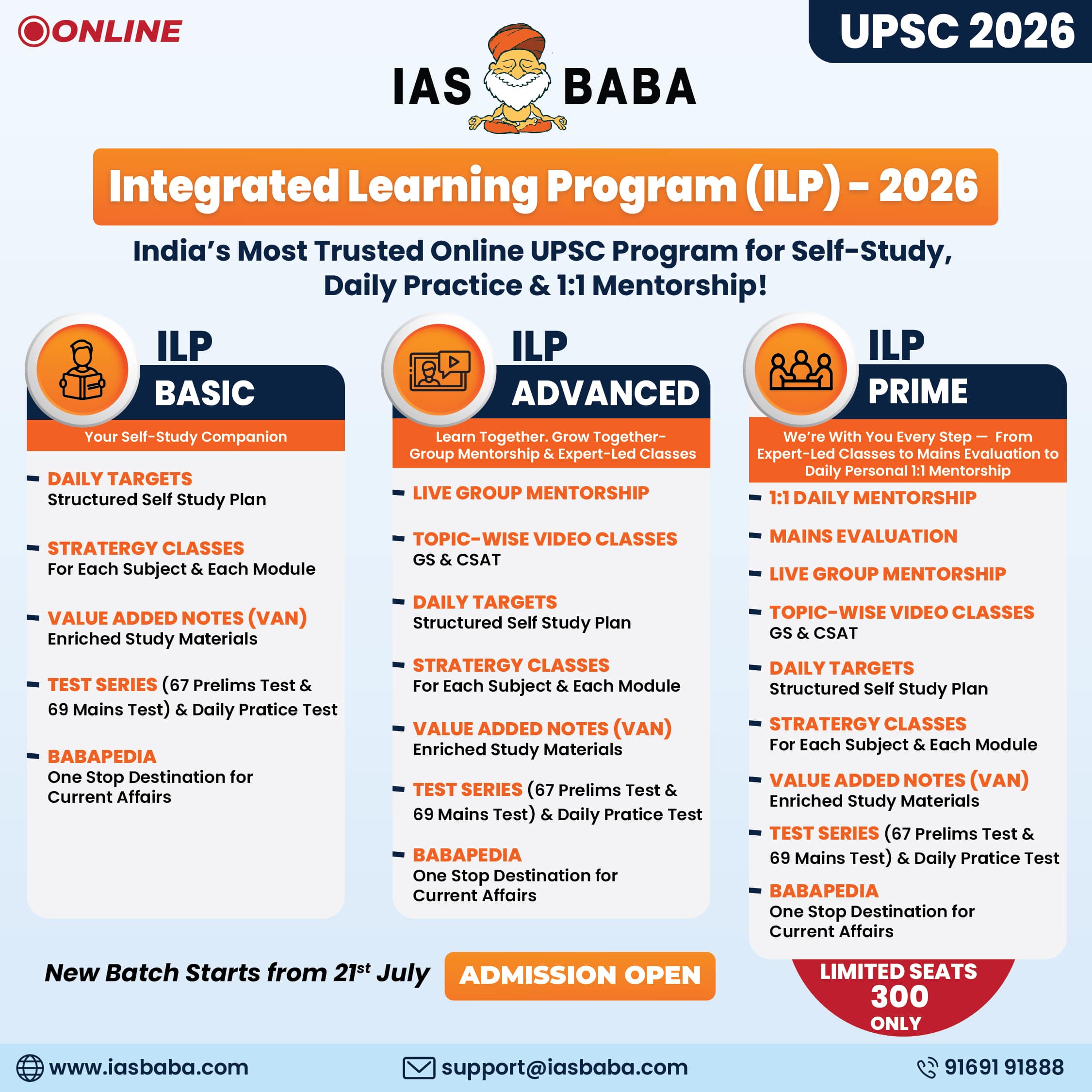IASbaba’s Daily CSAT Practice Test
ARCHIVES
Daily CSAT Practice Test
Everyday 5 Questions from Aptitude, Logical Reasoning, and Reading Comprehension will be covered from Monday to Saturday.
Make the best use of the initiative. All the best!
To Know More about Ace the Prelims (ATP) 2021 – CLICK HERE
Important Note:
- Don’t forget to post your marks in the comment section. Also, let us know if you enjoyed today’s test 🙂
- After completing the 5 questions, click on ‘View Questions’ to check your score, time taken and solutions.
Test-summary
0 of 5 questions completed
Questions:
- 1
- 2
- 3
- 4
- 5
Information
To view Solutions, follow these instructions:
- Click on – ‘Start Test’ button
- Solve Questions
- Click on ‘Test Summary’ button
- Click on ‘Finish Test’ button
- Now click on ‘View Questions’ button – here you will see solutions and links.
You have already completed the test before. Hence you can not start it again.
Test is loading...
You must sign in or sign up to start the test.
You have to finish following test, to start this test:
Results
0 of 5 questions answered correctly
Your time:
Time has elapsed
You have scored 0 points out of 0 points, (0)
| Average score |
|
| Your score |
|
Categories
- Not categorized 0%
| Pos. | Name | Entered on | Points | Result |
|---|---|---|---|---|
| Table is loading | ||||
| No data available | ||||
- 1
- 2
- 3
- 4
- 5
- Answered
- Review
-
Question 1 of 5
1. Question
A merchant fixes the sale price of his goods at 20% above the cost price. He sells his goods at 10% less than the fixed price. Find his percentage of profit
Correct
Solution (d)
Let the cost price be Rs 100
Marked price = Rs (100 + 20% of 100) = Rs 120
The goods are sold at the discount of 10%.
S.P. = (120 – 10% of 120)
Rs (120 – 12) = Rs 108
Profit = Rs (108 – 100) = Rs 8
Profit percentage = 8/100*100 = 8%
Incorrect
Solution (d)
Let the cost price be Rs 100
Marked price = Rs (100 + 20% of 100) = Rs 120
The goods are sold at the discount of 10%.
S.P. = (120 – 10% of 120)
Rs (120 – 12) = Rs 108
Profit = Rs (108 – 100) = Rs 8
Profit percentage = 8/100*100 = 8%
-
Question 2 of 5
2. Question
Mr Rahul invested an amount of Rs 12,800 divided in two different schemes A and B at the simple interest rate of 12% p.a. and 9% p.a. respectively. If the total amount of simple interest earned in 2 years be Rs 2,400, what was the amount invested in Scheme B?
Correct
Solution (d)
Let the sum invested in Scheme A be Rs X and that in Scheme B be Rs (12800 – X)
Then, (X*12*2)/100 + ((12,800-X)*9*2)/100 = 2,400
24X – 18X = 2,40,000 – (12,800 x 18)
6X = 9,600
X = 1,600 Rs
So, sum invested in Scheme B = Rs (12,800 – 1,600) = Rs 11,200.
Incorrect
Solution (d)
Let the sum invested in Scheme A be Rs X and that in Scheme B be Rs (12800 – X)
Then, (X*12*2)/100 + ((12,800-X)*9*2)/100 = 2,400
24X – 18X = 2,40,000 – (12,800 x 18)
6X = 9,600
X = 1,600 Rs
So, sum invested in Scheme B = Rs (12,800 – 1,600) = Rs 11,200.
-
Question 3 of 5
3. Question
Read the following passage and answer the items that follow. Your answer to these items should be based on the passages only.
The promise of finding long-term technological solutions to the problem of world food shortages seems difficult to fulfil. Many innovations that were once heavily supported and publicized, such as fish-protein concentrate and protein from algae grown on petroleum substrates have since fallen by the wayside. The proposals themselves were technically feasible, but they proved to be economically unviable and to yield food products culturally unacceptable to their consumers. Recent innovations such as opaque-2 maize, Antarctic krill, and the wheat-rye hybrid triticale seem more promising, but it is too early to predict their ultimate fate.
One characteristic common to unsuccessful food innovations has been that, even with extensive government support, they often have not been technologically adapted or culturally acceptable to the people for whom they had been developed. A successful new technology, therefore, must fit the entire sociocultural system in which it is to find a place. Security of crop yield, practicality of storage, palatability, and costs are much more significant than had previously been realized by the advocates of new technologies. For example, the better protein quality in tortillas made from opaque-2 maize will be of only limited benefit to a family on the margin of subsistence if the new maize is not culturally acceptable or is more vulnerable to insects.
The adoption of new food technologies depends on more than these technical and cultural considerations; economic factors and governmental policies also strongly influence the ultimate success of any innovation. Economists in the Anglo-American tradition have taken the lead in investigating the economics of technological innovation. Although they exaggerate in claiming that profitability is the key factor guiding technical change—they completely disregard the substantial effects of culture—they are correct in stressing the importance of profits. Most technological innovations in agriculture can be fully used only by large landowners and are only adopted if these profit-oriented business people believe that the innovation will increase their incomes. Thus, innovations that carry high rewards for big agribusiness groups will be adopted even if they harm segments of the population and reduce the availability of food in a country.
Further, should a new technology promise to alter substantially the profits and losses associated with any production system, those with economic power will strive to maintain and improve their own positions. Since large segments of the populations of many developing countries are close to the subsistence margin and essentially powerless, they tend to be the losers in this system unless they are aided by a government policy that takes into account the needs of all sectors of the economy. Therefore, although technical advances in food production and processing will perhaps be needed to ensure food availability, meeting food needs will depend much more on equalizing economic power among the various segments of the populations within the developing countries themselves.
It can be inferred from the passage that the author was unable to assess the truth of which of the following statements about opaque-2 maize?
Correct
Solution (d)
From the second paragraph we can extract this “For example, the better protein quality in tortillas made from opaque-2 maize will be of only limited benefit to a family on the margin of subsistence if the new maize is not culturally acceptable or is more vulnerable to insects.”
Hence option d is correct
Incorrect
Solution (d)
From the second paragraph we can extract this “For example, the better protein quality in tortillas made from opaque-2 maize will be of only limited benefit to a family on the margin of subsistence if the new maize is not culturally acceptable or is more vulnerable to insects.”
Hence option d is correct
-
Question 4 of 5
4. Question
Read the following passage and answer the items that follow. Your answer to these items should be based on the passages only.
The promise of finding long-term technological solutions to the problem of world food shortages seems difficult to fulfil. Many innovations that were once heavily supported and publicized, such as fish-protein concentrate and protein from algae grown on petroleum substrates have since fallen by the wayside. The proposals themselves were technically feasible, but they proved to be economically unviable and to yield food products culturally unacceptable to their consumers. Recent innovations such as opaque-2 maize, Antarctic krill, and the wheat-rye hybrid triticale seem more promising, but it is too early to predict their ultimate fate.
One characteristic common to unsuccessful food innovations has been that, even with extensive government support, they often have not been technologically adapted or culturally acceptable to the people for whom they had been developed. A successful new technology, therefore, must fit the entire sociocultural system in which it is to find a place. Security of crop yield, practicality of storage, palatability, and costs are much more significant than had previously been realized by the advocates of new technologies. For example, the better protein quality in tortillas made from opaque-2 maize will be of only limited benefit to a family on the margin of subsistence if the new maize is not culturally acceptable or is more vulnerable to insects.
The adoption of new food technologies depends on more than these technical and cultural considerations; economic factors and governmental policies also strongly influence the ultimate success of any innovation. Economists in the Anglo-American tradition have taken the lead in investigating the economics of technological innovation. Although they exaggerate in claiming that profitability is the key factor guiding technical change—they completely disregard the substantial effects of culture—they are correct in stressing the importance of profits. Most technological innovations in agriculture can be fully used only by large landowners and are only adopted if these profit-oriented business people believe that the innovation will increase their incomes. Thus, innovations that carry high rewards for big agribusiness groups will be adopted even if they harm segments of the population and reduce the availability of food in a country.
Further, should a new technology promise to alter substantially the profits and losses associated with any production system, those with economic power will strive to maintain and improve their own positions. Since large segments of the populations of many developing countries are close to the subsistence margin and essentially powerless, they tend to be the losers in this system unless they are aided by a government policy that takes into account the needs of all sectors of the economy. Therefore, although technical advances in food production and processing will perhaps be needed to ensure food availability, meeting food needs will depend much more on equalizing economic power among the various segments of the populations within the developing countries themselves.
The passage mentions all of the following as factors important to the success of a new food crop except the
Correct
Solution (c)
Again from the second paragraph we can observe the following statements
“Security of crop yield, practicality of storage, palatability, and costs are much more significant than had previously been realized by the advocates of new technologies.”
Also…… the better protein quality in tortillas made from opaque-2 maize will be of only limited benefit to a family on the margin of subsistence if the new maize is not culturally acceptable
From these statements we can infer that author is opposed to the case of Quality of the crop’s protein in the success of a new food crop.
Incorrect
Solution (c)
Again from the second paragraph we can observe the following statements
“Security of crop yield, practicality of storage, palatability, and costs are much more significant than had previously been realized by the advocates of new technologies.”
Also…… the better protein quality in tortillas made from opaque-2 maize will be of only limited benefit to a family on the margin of subsistence if the new maize is not culturally acceptable
From these statements we can infer that author is opposed to the case of Quality of the crop’s protein in the success of a new food crop.
-
Question 5 of 5
5. Question
Read the following passage and answer the items that follow. Your answer to these items should be based on the passages only.
The promise of finding long-term technological solutions to the problem of world food shortages seems difficult to fulfil. Many innovations that were once heavily supported and publicized, such as fish-protein concentrate and protein from algae grown on petroleum substrates have since fallen by the wayside. The proposals themselves were technically feasible, but they proved to be economically unviable and to yield food products culturally unacceptable to their consumers. Recent innovations such as opaque-2 maize, Antarctic krill, and the wheat-rye hybrid triticale seem more promising, but it is too early to predict their ultimate fate.
One characteristic common to unsuccessful food innovations has been that, even with extensive government support, they often have not been technologically adapted or culturally acceptable to the people for whom they had been developed. A successful new technology, therefore, must fit the entire sociocultural system in which it is to find a place. Security of crop yield, practicality of storage, palatability, and costs are much more significant than had previously been realized by the advocates of new technologies. For example, the better protein quality in tortillas made from opaque-2 maize will be of only limited benefit to a family on the margin of subsistence if the new maize is not culturally acceptable or is more vulnerable to insects.
The adoption of new food technologies depends on more than these technical and cultural considerations; economic factors and governmental policies also strongly influence the ultimate success of any innovation. Economists in the Anglo-American tradition have taken the lead in investigating the economics of technological innovation. Although they exaggerate in claiming that profitability is the key factor guiding technical change—they completely disregard the substantial effects of culture—they are correct in stressing the importance of profits. Most technological innovations in agriculture can be fully used only by large landowners and are only adopted if these profit-oriented business people believe that the innovation will increase their incomes. Thus, innovations that carry high rewards for big agribusiness groups will be adopted even if they harm segments of the population and reduce the availability of food in a country.
Further, should a new technology promise to alter substantially the profits and losses associated with any production system, those with economic power will strive to maintain and improve their own positions. Since large segments of the populations of many developing countries are close to the subsistence margin and essentially powerless, they tend to be the losers in this system unless they are aided by a government policy that takes into account the needs of all sectors of the economy. Therefore, although technical advances in food production and processing will perhaps be needed to ensure food availability, meeting food needs will depend much more on equalizing economic power among the various segments of the populations within the developing countries themselves.
According to the passage, the use of Antarctic krill as a food is an innovation whose future is
Correct
Solution (b)
The first paragraph says “Recent innovations such as opaque-2 maize, Antarctic krill, and the wheat-rye hybrid triticale seem more promising, but it is too early to predict their ultimate fate.”
Hence option b is correct.
Incorrect
Solution (b)
The first paragraph says “Recent innovations such as opaque-2 maize, Antarctic krill, and the wheat-rye hybrid triticale seem more promising, but it is too early to predict their ultimate fate.”
Hence option b is correct.












